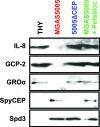A chemokine-degrading extracellular protease made by group A Streptococcus alters pathogenesis by enhancing evasion of the innate immune response
- PMID: 18174342
- PMCID: PMC2258835
- DOI: 10.1128/IAI.01354-07
A chemokine-degrading extracellular protease made by group A Streptococcus alters pathogenesis by enhancing evasion of the innate immune response
Abstract
Circumvention of the host innate immune response is critical for bacterial pathogens to infect and cause disease. Here we demonstrate that the group A Streptococcus (GAS; Streptococcus pyogenes) protease SpyCEP (S. pyogenes cell envelope protease) cleaves granulocyte chemotactic protein 2 (GCP-2) and growth-related oncogene alpha (GROalpha), two potent chemokines made abundantly in human tonsils. Cleavage of GCP-2 and GROalpha by SpyCEP abrogated their abilities to prime neutrophils for activation, detrimentally altering the innate immune response. SpyCEP expression is negatively regulated by the signal transduction system CovR/S. Purified recombinant CovR bound the spyCEP gene promoter region in vitro, indicating direct regulation. Immunoreactive SpyCEP protein was present in the culture supernatants of covR/S mutant GAS strains but not in supernatants from wild-type strains. However, wild-type GAS strains do express SpyCEP, where it is localized to the cell wall. Strain MGAS2221, an organism representative of the highly virulent and globally disseminated M1T1 GAS clone, differed significantly from its isogenic spyCEP mutant derivative strain in a mouse soft tissue infection model. Interestingly, and in contrast to previous studies, the isogenic mutant strain generated lesions of larger size than those formed following infection with the parent strain. The data indicate that SpyCEP contributes to GAS virulence in a strain- and disease-dependent manner.
Figures






Similar articles
-
Chemokine-cleaving Streptococcus pyogenes protease SpyCEP is necessary and sufficient for bacterial dissemination within soft tissues and the respiratory tract.Mol Microbiol. 2010 Jun;76(6):1387-97. doi: 10.1111/j.1365-2958.2010.07065.x. Epub 2010 Feb 10. Mol Microbiol. 2010. PMID: 20158613 Free PMC article.
-
Combinatorial Synthetic Peptide Vaccine Strategy Protects against Hypervirulent CovR/S Mutant Streptococci.J Immunol. 2016 Apr 15;196(8):3364-74. doi: 10.4049/jimmunol.1501994. Epub 2016 Mar 11. J Immunol. 2016. PMID: 26969753
-
Endopeptidase PepO Regulates the SpeB Cysteine Protease and Is Essential for the Virulence of Invasive M1T1 Streptococcus pyogenes.J Bacteriol. 2018 Mar 26;200(8):e00654-17. doi: 10.1128/JB.00654-17. Print 2018 Apr 15. J Bacteriol. 2018. PMID: 29378883 Free PMC article.
-
The two faces of Janus: virulence gene regulation by CovR/S in group A streptococci.Mol Microbiol. 2007 Apr;64(1):34-41. doi: 10.1111/j.1365-2958.2007.05649.x. Mol Microbiol. 2007. PMID: 17376070 Review.
-
Cellular interactions of covR/S mutant group A Streptococci.Microbes Infect. 2018 Oct-Nov;20(9-10):531-535. doi: 10.1016/j.micinf.2017.12.009. Epub 2017 Dec 26. Microbes Infect. 2018. PMID: 29287985 Review.
Cited by
-
The group A Streptococcus accessory protein RocA: regulatory activity, interacting partners and influence on disease potential.Mol Microbiol. 2020 Jan;113(1):190-207. doi: 10.1111/mmi.14410. Epub 2019 Nov 11. Mol Microbiol. 2020. PMID: 31660653 Free PMC article.
-
The transcriptional programme of human heart valves reveals the natural history of infective endocarditis.PLoS One. 2010 Jan 28;5(1):e8939. doi: 10.1371/journal.pone.0008939. PLoS One. 2010. PMID: 20126625 Free PMC article.
-
The N-terminal ELR+ motif of the neutrophil attractant CXCL8 confers susceptibility to degradation by the Group A streptococcal protease, SpyCEP.J Biol Chem. 2025 May;301(5):108448. doi: 10.1016/j.jbc.2025.108448. Epub 2025 Mar 25. J Biol Chem. 2025. PMID: 40147770 Free PMC article.
-
Peptide pheromone signaling in Streptococcus and Enterococcus.FEMS Microbiol Rev. 2014 May;38(3):473-92. doi: 10.1111/1574-6976.12046. Epub 2013 Oct 31. FEMS Microbiol Rev. 2014. PMID: 24118108 Free PMC article. Review.
-
The 4.5S RNA component of the signal recognition particle is required for group A Streptococcus virulence.Microbiology (Reading). 2010 May;156(Pt 5):1342-1350. doi: 10.1099/mic.0.036558-0. Epub 2010 Jan 28. Microbiology (Reading). 2010. PMID: 20110295 Free PMC article.
References
-
- Brinkmann, V., U. Reichard, C. Goosmann, B. Fauler, Y. Uhlemann, D. S. Weiss, Y. Weinrauch, and A. Zychlinsky. 2004. Neutrophil extracellular traps kill bacteria. Science 3031532-1535. - PubMed
-
- Carlsson, F., C. Sandin, and G. Lindahl. 2005. Human fibrinogen bound to Streptococcus pyogenes M protein inhibits complement deposition via the classical pathway. Mol. Microbiol. 5628-39. - PubMed
-
- Cockerill, F. R., III, R. L. Thompson, J. M. Musser, P. M. Schlievert, J. Talbot, K. E. Holley, W. S. Harmsen, D. M. Ilstrup, P. C. Kohner, M. H. Kim, B. Frankfort, J. M. Manahan, J. M. Steckelberg, F. Roberson, W. R. Wilson, et al. 1998. Molecular, serological, and clinical features of 16 consecutive cases of invasive streptococcal disease. Clin. Infect. Dis. 261448-1458. - PubMed
Publication types
MeSH terms
Substances
Grants and funding
LinkOut - more resources
Full Text Sources
Molecular Biology Databases

